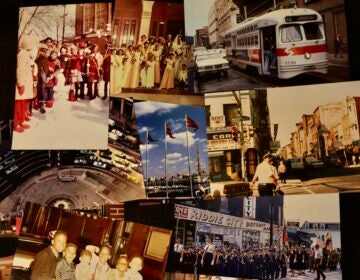Teenage photographers taught to speak their minds in ‘Young Americans’
Teenage photographers were mentored by immigration photojournalist Ada Trillo to express their own lives through pictures.

''Young Americans,'' a photography exhibit at InLiquid gallery at the crane Arts Building, presents new work from Ada Trillo along with work from students of Photography without Borders (PWB), a group of Latinx teens whom Trillo mentored in 2020-2021. (Emma Lee/WHYY)
Philadelphia-based photographer Ada Trillo has spent years following people trying to cross the border into the United States, documenting their struggles, and showing the dignity and hardship of immigration.
Since 2017, Trillo has been following groups of people moving north through Central America. She followed a 2020 caravan, walking 1,800 miles toward the American border, which former President Trump declared a “national emergency.” She hopped a freight train with immigrants traveling north from Chiapas on La Bestia, also known as “the death train.” She also lived in Tijuana with thousands of asylum-seekers waiting to cross into the United States during the period when Trump’s “Remain in Mexico” policy denied them entry.

In her new exhibition at the InLiquid Gallery, her photos are shown alongside the work of teenage Latinas in Philadelphia documenting their own lives. “Young Americans” juxtaposes the struggles of coming to the U.S. with the struggles of growing up in the U.S.
By the invitation of InLiquid and Photography Without Borders, an after-school youth photography program, Trillo mentored five 14- and 15-year-old girls for about a year via weekly Zoom sessions, sometimes conducted from Tijuana where she was living with immigrant asylum-seekers.
“I’ve been mentoring children: I started a program in Juárez teaching migrant children photography,” said Trillo, who is originally from Juárez and has lived in Philadelphia for two decades. “When I got the opportunity to do it in Philadelphia — it’s the place where I feel welcomed, loved, my art career started developing — I mean, it was a no-brainer.”
The young women in the program were not new to photography. They were literally Shutterbugs, the name of a school photography club started by teacher Tony Rocco, now the executive director of Photography Without Borders.

The young people in PWB learn the art and techniques of photography by taking pictures of what they like. Gabriella Borges, 14, said she started taking pictures five years ago of the people around her.
“It was me having this little Polaroid, because I love to take pictures of my family,” said Borges, born in Philadelphia with family roots in Puerto Rico. “I could see my dad talking about his mom and how he wishes he could tell me all the stuff. And I’m, like, ‘If I take pictures now, I’ll be able to show these to my little cousins as they get older.’”
With the guidance of Trillo, Borges explored photography as a way of communicating ideas and taking risks. Borges started shooting pictures of statues, whose expressions carved in stone can be artfully manipulated through light and camera angle.
In “Young Americans,” Borges included a picture of a religious statue holding a cross aloft. Whether the figure is hoisting up the cross or pulling it down is up for interpretation. She calls it “Betrayal.”

“People automatically look at it and they’re, like, ‘It’s good. Inherently, it’s good. It’s perfect.’” she said. “But you still need to explore that to really decide whether or not it’s good inherently for you.”
Coming from a family with a strong religious tradition – her grandmother is a pastor – Borges’ act of questioning religion in photography brings some personal risk.
“My grandma, she said, ‘We’re going to have a talk,’” said Borges. “But then she went on a trip. She’s going to be off for a while, so I’m not going to be alone with her anytime soon.”
Rocco, the director of the program, said the mentorship class with Trillo was meant to teach the girls to use photography to send a message. It was up to them to find something they wanted to say.
“Find your own story,” said Rocco. “They rose to the occasion. I mean, they are only 14 or 15 years old. It didn’t happen immediately. They brought some photos. They got feedback from their classmates, they thought about it, brought another batch of photos. Over time, a body of work developed that each one of them felt comfortable with. That ended up being their story.”

Nelian Asport Morales, 14, said she usually does not like taking pictures of people. She gravitates to landscapes and flowers, using vibrant color to express joy. For this project, however, he used black and white film to shoot her younger sister looking at a fashion magazine.
Morales, originally from Puerto Rico, wanted to say something about oppressive beauty standards imposed on young girls. The photo is called “Early Insecurities.”
“Which is why I used black and white, to show that I’m being serious about this,” she said. “You should listen to what I’m trying to show you in my picture, and listen to what I have to say about it.”
“Early Insecurities” is a staged photo. Morales said her younger sister, in contrast to the message of the photo, is normally a very happy and well-adjusted 9-year-old. Morales posed her looking carefully at the pages of a fashion magazine that would normally be popping with color. In black and white, the pages become bland.

“When you open up a magazine, there’s always the colorful things that catch your eyes,” she said. “Once you take away the color, it just becomes something regular.”
It was important to Trillo that the girls she mentored were Latina, like her. On one hand it was more practical, as Trillo speaks English as a second language and feels more comfortable in Spanish. She also said they have a shared background on which they can build a relationship.
“I am an Indigenous person from Latin descent, and I feel that the opportunities for us are not as much as they are for other ethnicities,” she said. “Why not give back to my own people, and people that have not been given the best opportunities?”
Trillo used her own documentary work as examples to show the class, but her pictures of Central American migrants come out of a different kind of photojournalism practice, to show the lives of people during an extraordinary and often dangerous period of transition and geopolitcal oppression.
Trillo says she did not want to teach the teenagers about photojournalism, exactly, but inspire them to use photography to communicate ideas they are passionate about.

“I have very close ties to the story of migration, a very close, personal story to the story of migration. That’s why I do it,” said Trillo. “What is close to your heart, document that. That’s what you’re going to be the most successful at because you’re going to have the most passion in.”
The young photographers are now getting a taste of having their photographs seen in the wider world. In addition to the gallery show at InLiquid, which has just been extended to Jan. 29, their work has been included in the national, youth-oriented bilingual print magazine Motivos, whose current issue is devoted entirely to Photography Without Borders.
WHYY is your source for fact-based, in-depth journalism and information. As a nonprofit organization, we rely on financial support from readers like you. Please give today.







